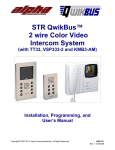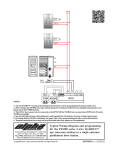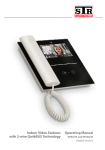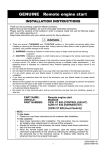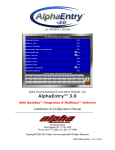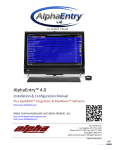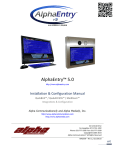Download Alpha Communications STR QwikBus VSP333-3 User`s manual
Transcript
STR QwikBus™ 2 wire Color Video Intercom System (with TT33-2, VSP333-3 and KBS3-2) Installation, Programming, and User’s Manual Copyright© 2013, Alpha Communications®, All Rights Reserved AWD184 Rev. 1.0 - 09/2013 STR QwikBus™ 2 wire Color Video Intercom System 1 1 2 Introduction Compatible Inside Stations Planning the Installation Wiring Diagrams Single Entry STR Modular Panel Multiple Entry STR Modular Panels Single Entry Custom Panel Multiple Entry Custom Panels Important Notes on Monitor Riser Connections EVB33 Distribution Units Dipswitch Settings System Camera Options – Lobby Panels, and Observation End of Line Resistors Jumper Locations The Matrix – Wiring Custom Panel Buttons to the TT33-2 E32 Matrix Extenders The IC2 database chip Opening and Closing the VFS1500/1000 VH3033 Inside Stations Programming the QwikBus™ System -- Open Voice (VFS1500/1000) Programming (on site) Programming Inside Stations for parallel operation One Man Bench Programming Programming VFS1500 stations for Intercommunication Programming the QwikBus™ System --Handset (VHC3033-2) Programming (on site) Programming Inside Stations for parallel operation One Man Bench Programming 4 5 6 7 8 9 10 11 12 13 13 14 14 15 15 15 16 17 18 18 18 19 USER Operation VHC3033-2 Color Handset VFS1500/ VFS1000 Monitors & FS1500/FS1000 Audio Stations b 20 21 The STR QwikBus™ takes advantage of the latest in digital technology to provide a high tech, high quality color video intercom system operating on a 2 common wire BUS. QwikBus™ video monitor stations all feature a crystal clear 4" LCD Color screen (measured diagonally) and can be surface or flush mounted (with optional UMV1000 flush housing). You can choose from the VFS1000 series (hands free VOX without internal communications) or the VFS1500 series hands free VOX (with internal communications for up to 5 units per apt.), as well as handset style monitors and audio only stations all on the same 2 twisted wires. Audio only stations are available as well and can be mixed and matched to suit your particular application. QwikBUS™ COMPATIBLE INSIDE STATIONS VFS1000 COLOR MONITOR VFS1500 COLOR MONITOR Voice Operated hands free Voice Operated hands free Available in 6 Designer Finishes Available in 6 Designer Finishes Communicate internally between up to 5 stations per apartment. FS1000 SERIES AUDIO STATION FS1500 SERIES AUDIO STATION Voice Operated Hands free Voice Operated Hands free Available in 6 Designer Finishes Available in 6 Designer Finishes Crystal Clear Sound Crystal Clear Sound Internal Communications Capable VHC3033-2 COLOR MONITOR W/HANDSET HT3033 AUDIO HANDSET Available in White, Titanium, and Anthracite Available in White, Titanium, and Anthracite 1 PLANNING THE INSTALLATION Is this a COLOR Video installation? This manual is written expressly for the QwikBus™ 2-wire Color systems that will be using the Inside monitors listed on the previous page. If you are installing a Black and White system, please refer to the QwikBus™ 4-wire Black & White Manual. How many apartments? QwikBus™ can run up to 120 apartments and can exceed that number if specially designed. If you will be installing a larger system please contact Alpha Communications® for assistance. How many apartments will need more than 1 monitor? An apartment can have up to 4 monitors and or audio stations that will ring when the entry button is pressed. A fifth can be added a custom TT33-8P as opposed to the standard TT33-2. Will these multiple monitor apartments need intercommunication? Intercommunication is only available using the VFS1500/ FS1500 series stations which allow you to ring 2-4 other stations in the apartment depending on the equipment used. How many Entrances? Typically, QwikBus™ can have up to 8 Entrance panels. If you will be installing a larger number of entrances please contact Alpha Communications® for design assistance. Modular Panel? STR™ modular panels are available in White, Titanium, and Dark Brown and are usually used in small installations from a 1 button residential application up to multi-apartment configurations and feature beautiful contemporary looks, illuminated buttons, and outside weather resistance. Stainless Steel or Brass Panel? Alpha Communications® can custom design and build flush and surface mount entry panels in Stainless Steel or Polished Brass with all necessary apartment button numbering and address engraving. How many observation cameras will be in the system? Additional Cameras can be added in addition to the Entrance Cameras for a total of 8, enabling the apartment monitors to view the various feeds on demand. What type of Inside stations will you use? Although all the compatible stations connect the same way, each model does have certain capabilities and advantages depending on the needs of the tenant and can be exchanged for another unit at anytime if necessary by simply installing the 2 wires and reprogramming the system to recognize the unit. 2 Are you running new wire or using existing wire from a previous system? Although digital systems are fairly forgiving in wiring requirements, they are still susceptible to RFI from unusually strong nearby transmitters, EMI from electrical lines running nearby, or existing wiring that is not twisted, in poor condition, or not a suitable gauge. Please refer to the wiring thickness chart below to determine the minimum recommended wire gauge needed. If the existing wiring is more than 12 years old, has deteriorating insulation, questionable splice connections, corrosion, or is not configured as twisted pair wiring, it is highly recommended that new wire be run. To reduce the risk of interference problems: Always use a single twisted pair wire for the two wire BUS line. Do NOT double wires to increase effective wire diameter. This will cause interference problems. Do NOT install any unused additional wires with open ends. Never connect the shield from a cable, or connect the shield from one cable to another. Use a separate cable to the door strike from the SP333. Only use a 12VAC door strike or 12VAC relay with less than 1 amp draw. If it is absolutely necessary to run the door strike wiring in the same cable as the BUS line, you must use a transient voltage suppressor at the door strike end. Loop resistance should be less than 20 ohms. Twisted pair is always recommended. Cat5, Cat5E, Cat6, and the new Cat7 spec. wire is NOT recommended. How many risers will you be using? The recommended maximum number of monitors on a riser is 8-10 with each riser originating from the VSP333-3 Control Unit, including from the EVB333 Amplified Splitter(s) if your system requires them. For technical assistance and help determining equipment needed please call: Alpha Communications® at (800) 666-4800 Monday – Friday 8:30- 5:00 pm 3 System Notes – 2 wire COLOR with Single Modular Entry If you require more than 3 VSP333-3 Units, please use MXV333 instead. Contact Alpha Communications® for more information. A Single Entry Modular system requires the following dipswitch settings on the back of the TSMB3 unit: Switches 4, 5, & 6 identify the entrance number (all OFF = Entrance 1) Switch 3 If the door strike is to be connected to the SP333 (Tö1) = OFF If the door strike is to be connected to the TSMB3 (Tö) = ON For more information refer to Page 10 - Dipswitch Settings. Be sure that the End of Line Jumpers are used on the camera circuit board and in the last monitor on each riser. If the last unit on a riser is an audio only unit, the End of Line Jumper would still be used on the last monitor on that riser. This is important for best picture quality. For more information refer to Page 12 - End of Line Jumper Locations. When connecting C333-2 harness between SP333 and SNT333, ALWAYS observe 24VDC Polarity. 4 System Notes – 2 wire COLOR with Multiple Modular Entries If you require more than 3 VSP333-3 Units, please use MXV333 instead. Contact Alpha Communications® for more information. Multiple Entry Modular systems require the following dipswitch settings on the back of the TSMB3 unit: Switches 4,5, &6 identify the entrance number. In the above example: Entrance #1 = 4 OFF/ 5 OFF/ 6 OFF Entrance #2 = 4 ON / 5 OFF/ 6 OFF Switch 3 If the door strike is connected to the SP333 (Tö2) = OFF (as shown at Entrance 2) If the door strike is connected to the TSMB3 (Tö) = ON (as shown at Entrance 1) For more information refer to Page 10 - Dipswitch Settings. Be sure that the End of Line Jumpers are used on the camera circuit board and in the last monitor on each riser. If the last unit on a riser is an audio only unit, the End of Line Jumper would still be used on the last monitor on that riser. This is important for best picture quality. For more information refer to Page 12 - End of Line Jumper Locations. When connecting C333-2 harness between SP333 and SNT333, ALWAYS observe 24VDC Polarity. 5 System Notes – 2 wire COLOR with Single Custom Panel Entry If you require more than 3 VSP333-3 Units, please use MXV333 instead. Contact Alpha Communications® for more information. The TT33-2 SPEAKER/MICROPHONE/ CONTROLLER allows you to use QwikBus™ with a custom panel or existing dry contact type entry panel by converting the button presses to a digital signal through an electronic matrix. This matrix is discussed in detail on Page 13. A Single Panel Entry system requires the following dipswitch settings on the TT33-2 unit: Switches 4, 5, & 6 identify the entrance number (all OFF = Entrance 1) Switch 3 If the door strike is to be connected to the SP333 (Tö1) = OFF For more information refer to Page 10 - Dipswitch Settings. Be sure that the End of Line Jumpers are used on the camera circuit board and in the last monitor on each riser. If the last unit on a riser is an audio only unit, the End of Line Jumper would still be used on the last monitor on that riser. This is important for best picture quality. For more information refer to Page 12 - End of Line Jumper Locations. NOTE: When using a Coaxial cable into a KBS3-2, ALWAYS connect a 75Ω (for RG-59) or 50 Ω (for RG-6) End-of-Line resistor between the coax center lead terminal and the (-) terminal on the KBS3-2. Failure to do this may cause degradation of the video signal. When connecting C333-2 harness between SP333 and SNT333, ALWAYS observe 24VDC Polarity. 6 System Notes – 2 wire COLOR with Multiple Custom Panel Entries If you require more than 3 VSP333-3 Units, please use MXV333 instead. Contact Alpha Communications® for more information. Multiple Custom Panel Entry systems require the following dipswitch settings on the back of the TT33-2 units: Switch 3 If the door strike is connected to the SP333 (Tö2) = OFF (as shown at Entrance 2) Switches 4,5, &6 identify the entrance number. In the above example: Entrance #1 = 4 OFF/ 5 OFF/ 6 OFF Entrance #2 = 4 ON / 5 OFF/ 6 OFF Switches 4,5, &6 on the KMB3-2 should be set the same as the corresponding Entry. For more information refer to Page 10 Dipswitch Settings. Be sure that the End of Line Jumpers are used on the camera circuit board and in the last monitor on each riser. If the last unit on a riser is an audio only unit, the End of Line Jumper would still be used on the last monitor on that riser. This is important for best picture quality. (refer to Page 12) End of Line Jumper Locations. NOTE: When using a Coaxial cable into a KBS3-2, ALWAYS connect a 75Ω (for RG-59) or 50 Ω (for RG-6) End-of-Line resistor between the coax center lead terminal and the (-) terminal on the KBS3-2. Failure to do this may cause degradation of the video signal. When connecting C333-2 harness between SP333 and SNT333, ALWAYS observe 24VDC Polarity. 7 System Notes – 2 wire COLOR: Important Information on Monitor Riser Connections This section discusses the proper procedure for connecting monitors on a riser. Although a digital system is very forgiving, it is best to follow these rules during installation to maximize performance and minimize potential problems. Using existing wiring: When using existing wiring there are many things that can cause problems. The first is of course, wiring condition and gauge. Solid or stranded does not matter but a minimum of 18 gauge twisted shielded wire with the shield NOT connected together is strongly recommended. Using any lighter gauge may result in loss of performance and/or introduction of interference from outside power sources. Many installers run the cable the easiest way and this, unfortunately, is usually by running the wire in a conduit or small enclosure right along side AC power lines, near fluorescent ballasts, or machinery. It is therefore suggested that you run your own wiring for this job in the recommended way, and avoid wiring with unknown potential issues. If this is not possible, it is best to advise the customer that the system may not work up to its full potential especially with regard to video display. Proper BUS Connections to the Monitors: Although the polarity of the BUS connections on a monitor on a line is not important, it is good form to reverse the connections from monitor to monitor on a BUS line to prevent the propagation of signal distortion by putting them “out of phase” with each other. On the picture below, note how the monitors are “reverse connected” as they go up a riser. 8 All Monitor BUS lines must be terminated with an End of Line resistor on the last monitor in the run. This is built into each monitor and can be installed by putting a jumper connector on J1. The location of this jumper is illustrated on Page 12. If a BUS is not terminated properly, the electronic characteristics of the line will change resulting in signal degradation and poor video quality. Using EVB33 Distribution Units with BUS risers: Always try to avoid branching or “T-Tapping” to connect monitors from a riser as this will cause changes in the riser electronic characteristics which may cause signal degradation and poor video quality. However, when it is necessary to “T-Tap” a line from a BUS line, there are two important things to remember. 1. Use an EVB33 for each “T-Tap” to help minimize issues with signal propagation. This can be done in an “in-line” method alternating polarity of the monitors, (maximum of 6 monitors or 8-10 monitors on the total riser) or in a “star” pattern with up to three monitors on their own “sub” risers. 2. Always use the End of Line jumper at the physical end of a riser line. Both of these items are illustrated below. 9 Dipswitch Settings – Entries & Door Strikes The QwikBus™ system uses dipswitches for identification of Entry stations, additional cameras, and to enter “Programming Mode”. Entrance Panels must have a unique code so the system knows where the call is coming from and which door to open. Dipswitches 4, 5, & 6 on the back of the Speaker/Microphone Unit (TSMB3 (Modular style) or TT33-2 (Custom style)) assign this code as shown in the chart below. When a Door Strike is used, It can be connected locally to the TSMB3 (Modular style panels) or TT33-2 (Custom style Panels) Tö terminals, or connected to the SP333 Controller at the Tö1, Tö2, Tö3, or Tö4 terminals (number is related to the entry number). You must let the system know which connection you will use by the position of the #3 dipswitch for each entry. Dipswitch #3 = OFF (SP333) or ON (TSMB3 or TT33-2). The entries DO NOT have to be set alike. TSMB3 Dipswitch Location TT33-2 Dipswitch Location 10 Entrance Panel Cameras When using a Modular system, The Modular Camera (KMBC3*) is automatically identified by being connected directly to the TT33-2 and takes the same Entrance number (1-8) of the TT33-2. When using a Custom Panel with a TT33-2 Speaker/Microphone/Controller, You can use either a pinhole or CCTV type analog camera with it’s own power supply for system video input. This camera will connect by coax to the KBS3-2 which is automatically identified by being connected directly to the TT33-2 and takes the same Entrance number (1-8) of the TT33-2 using dipswitches 4, 5 and 6. Using analog cameras as add on observation cameras to the system. You can add CCTV type cameras to the system that are not related to an entrance panel to allow for observation of other areas using the KBS3-2. As an example you could have 2 entries to the building using Camera #1 & #2, and use 3 observation cameras set as camera #3, #4, & #5. When a visitor rings from Entrance #1, camera #1 will come on the monitor to display the visitor, but the resident can also cycle through all five cameras by pressing the button. When using any other camera(s) the KBS3-2 module must be used. This module has two functions: 1. Converts the analog camera video signal to a digital signal that is used by the QwikBus™ system. The analog signal is fed into this module from any pinhole or CCTV type camera by a standard RG59 or RG6 coax and sends the converted to digital signal out through the BUS connections to the system. 2. Establishes a Camera number for identification. If this camera is addressed as # 2 for example, This KBS3-2 would be set to #2 using the dipswitches 4,5,&6 (7 is not used). The 8 combinations are shown below. NOTE: When using a Coaxial cable into a KBS3-2, ALWAYS connect a 75Ω (for RG-59) or 50 Ω (for RG-6) End-of-Line resistor between the coax center lead terminal and the (-) terminal on the KBS3-2. Failure to do this may cause degradation of the video signal. 11 BUS End-of-Line Resistors – Jumper Locations For proper system operation, the last video monitor on a BUS riser as well as the last camera on a run must have an End-of-Line Resistors. These resistors are built in to the printed circuit boards and can be connected by installing the jumper on the two pins labeled J1. Usually these jumpers are supplied on all the monitors and camera boards and must be removed if the unit is not the last camera or monitor connected to the BUS line. If there is only one camera used or one monitor used, the End-of-Line resistors must still be used. The Chart to the left shows the locations of the J1 pins on the different circuit boards. NOTE: Do not confuse this End-of-Line Resistor with the End-of Line resistor required at the end of a coax cable entering the KBS3-2. See page 9 for more information. 12 The Matrix – Wiring Pushbuttons to the TT33-2 When using an STR™ Modular Button assembly, the system can read which switch is being pressed by electronics built into the switches. In the case of a Custom Panel, these electronics are built into the TT33-2 and you must run wires to assign each button to a position in a matrix. Modular Button Assy. Close up of TT33-2 Matrix Connections The matrix consists of Common Connections a,b,c, & d and numbers 1 through 6. Apartment 101 102 103 104 201 202 203 204 301 302 303 304 PH1 PH2 PH3 Connections A 1 A 2 A 3 A 4 A 5 A 6 B 1 B 2 B 3 B 4 B 5 B 6 C 1 C 2 C 3 The chart to the left shows an example of how a 15 button panel could be connected using combinations of letters and numbers to give each button a unique identification in the electronic matrix. As long as each button is connected to a unique combination of one letter and one number then the system will be able to assign addresses to each button. Using the matrix on the TT33-2 module, you can get 4x6 (24) unique combinations. One of these combinations (DL) can be used for special functions, so you can have up to a total of 23 or 24 apartments using the TT33-2 alone. If your system has more apartments you may add the following parts (one for each entry) which will extend the matrix by giving you more numeric connections. Please refer to the chart below. # of Apartments Additional Components 1 – 23 or 24 --- 24 – 55 or 56 1 - E32 56 – 87 or 88 2 - E32 88 – 119 or 120 3 - E32 For systems larger than 120 apartments, contact Alpha Communications® for assistance. 13 The IC2 Database Chip The QwikBus™ system has 8 pin nonvolatile IC chips located on the back of each TSMB3 Speaker Microphone Module (in the Modular style Entry Panels) or TT33-2 Speaker Microphone Module (in the Custom style Entry Panels). Each unit has this chip which maintains the programming for that specific entry. If you have to replace a TSMB3 or TT33-2 unit, you can remove the IC2 from the old unit and install it into the new unit so you do not have to reprogram that entrance. When doing this replacement, be sure to install it in the correct polarity indicated by the mark on the chip. Opening and Closing the VFS1000/ VFS1500/VHC3033-2 Inside Stations Arrows indicate mounting screws NOTE: Special Tool shown above is required for opening VFS/FS panels as well as servicing Modular Entry Panels. Part # 13510 14 PROGRAMMING SECTION for OPEN VOICE STYLE NOTE: Depending on your choice of Entry Panel, you will either be using a TT33-2 or TSMB3 Module. The TT33-2 and the TSMB3 will both be referred to in this section as the Speaker/Microphone Programming the QwikBus™ System -- Open Voice (VFS1500/1000 FS1500/1000) Programming the system is easily done with two installers. One to move from apartment to apartment working with the monitors, and one to be at the entry panel pressing the corresponding buttons. 1. Move Dipswitch 1 at Speaker/Microphone to ON position (Enter Programming Mode). 2. Press ON/OFF Button of Apartment Station to be programmed. (Opens communication to the Entry Panel, Installers will be able to talk to each other). 3. Press the Entry Button to be assigned to the Apartment Station (4 beeps at the Speaker/Microphone will indicate successful programming). 4. Press ON/OFF Button of Apartment Station. 5. Repeat Steps 2 through 4 for all apartments. 6. When Programming is completed move Dipswitch 1 at Speaker/Microphone to OFF position (Normal Operating Mode). Programming Indoor Stations for Parallel Operation You can program up to 4 stations to ring with each pushbutton ( either for a residential system or multiple stations in an apartment). 1. Move Dipswitch 1 at Speaker/Microphone to ON position (Enter Programming Mode). Check that Dipswitch 2 is in the OFF position. 2. Press ON/OFF Button of Apartment Station to be programmed. (Opens communication to the Entry Panel, Installers will be able to talk to each other). 3. Press the Entry Button to be assigned to the Apartment Station (4 beeps will sound at the Speaker/Microphone). Press ON/OFF Button of Apartment Station (turn off). 4. Move Dipswitch 2 at Speaker/Microphone to ON position. 5. Press ON/OFF Button of Apartment Station to be programmed. (Opens communication to the Entry Panel, Installers will be able to talk to each other). 6. (TSMB3) Hold down the “Light Button” while pressing the Entry Button used in Step 3. OR (TT33-2) Press the same Entry Button used in Step 3. 7. Press ON/OFF Button of Apartment Station. 8. Repeat Steps 5 through 7 for each additional parallel station. 9. Move Dipswitches 1 & 2 to OFF position. 15 One Man Bench Programming -- Open Voice (VFS1500/1000 FS1500/1000) If you prefer, the system can be preprogrammed on the bench to minimize your on-site time and eliminate the necessity of a second installer. To do this the inside stations can be connected separately one after another to the Speaker/ Microphone Module (either the TSMB3 or the TT33-2) using the special programming cable (Part # EMPK-VFS/FS for handset-free type stations or Part # EMPK-VH/HT for handset type stations), or just using 2 wires between the BUS terminals of both. Below is a step by step procedure for this method. 1. Connect the TT33-2 or TSMB3 Speaker/Mic unit to BUS power and plug in programming cable to the J1 terminals indicated by the blue arrow. 2. Move Dipswitch 1 to ON (programming mode). 3. Plug in other end of the cable to one indoor station as shown. until you hear a single tone (approx. 3 sec.) 4. Hold down the light button 5. Push the corresponding entry pushbutton. If the programming is successful you will hear 4 tones at the Speaker/Mic unit. 6. Unplug the indoor station and mark it with the corresponding pushbutton to avoid a mix-up. 7. Plug in the next indoor station and repeat steps 4 through 6 for the remaining units. 8. When programming is completed, Move Dipswitch #1 back to OFF (Normal mode) 16 Programming Open Voice VFS1500 for Intercommunication You can install up to five VFS1500 stations and program them for intercommunication in the same residence/ apartment. To program a VFS1500 to ring when one of the numeric buttons on another unit is pressed: 1. At the Calling station, press and hold the button you wish to call the second station until you hear a short tone. At this time the red LED will be blinking indicating that the first station is in programming mode. button. You will hear a tone and 2. Go to the second station and press the ON/OFF the system will exit programming mode. The calling station will now ring the second station when that numeric button is pressed. 3. Repeat this procedure for all units being called from the first station, then move to the second station and program all it’s buttons as needed, then the third etc., until all units are programmed. NOTE: To leave programming mode without changing programming, press the function button. To delete programming from a numeric button: 1. Press and hold the button you wish to deprogram. In approx. 3 seconds you will hear a short tone. At this time the red LED will be blinking indicating that the first station is in programming mode. 2. Continue to depress the button until you hear the tone a second time. The programming for that button is now deleted. 17 PROGRAMMING SECTION for HANDSET STYLE NOTE: Depending on your choice of Entry Panel, you will either be using a TT33-2 or TSMB3 Module. The TT33-2 and the TSMB3 will both be referred to in this section as the Speaker/Microphone Programming the QwikBus™ System – Handset Style (VHC3033-2 / HT3033) Programming the system is easily done with two installers. One to move from apartment to apartment working with the monitors, and one to be at the entry panel pressing the corresponding buttons. 1. Move Dipswitch 1 at Speaker/Microphone to ON position (Enter Programming Mode). 2. Lift Handset of Apartment Station to be programmed. (Opens communication to the Entry Panel, Installers will be able to talk to each other). 3. Press the Entry Button to be assigned to the Apartment Station (4 beeps at the Speaker/Microphone will indicate successful programming). 4. Hang up Handset of Apartment Station. 5. Repeat Steps 8 through 10 for all apartments. 6. When Programming is completed move Dipswitch 1 at Speaker/Microphone to OFF position (Normal Operating Mode). Programming Indoor Stations for Parallel Operation You can program up to 4 stations to ring with each pushbutton (either for a residential system or multiple stations in an apartment). Up to 8 stations can be programmed to ring with the special TSMB3-8 module. 1. Move Dipswitch 1 at Speaker/Microphone to ON position (Enter Programming Mode). Check that Dipswitch 2 is in the OFF position. 2. Lift Handset of Apartment Station to be programmed. (Opens communication to the Entry Panel, Installers will be able to talk to each other). 3. Press the Entry Button to be assigned to the Apartment Station (4 beeps will sound at the Speaker/Microphone). Hang up Handset of Apartment Station. 4. Move Dipswitch 2 at Speaker/Microphone to ON position. 5. Lift Handset of next Apartment Station to be programmed. (Opens communication to the Entry Panel, Installers will be able to talk to each other). 6. (TSMB3) Hold down the “Light Button” while pressing the Entry Button used in Step 3. OR (TT33) Press the same Entry Button used in Step 3. 7. Hang up Handset of Apartment Station. 8. Repeat Steps 10 through 17 for each additional parallel station. 9. Move Dipswitches 1 & 2 to OFF position. 18 One Man Bench Programming -- Handset Style (VHC3033-2 / HT3033) If you prefer, the system can be preprogrammed on the bench to minimize your on-site time and eliminate the necessity of a second installer. To do this the inside stations can be connected separately one after another to the Speaker/ Microphone Module (either the TSMB3 or the TT33-2) using the special programming cable (Part # EMPK-VFS/FS for handset-free type stations or Part # EMPK-VH/HT for handset type stations) or by running 2 wires between the BUS terminals of both. Below is a step by step procedure for this method. 1. Connect the TT33-2 or TSMB3 Speaker/Mic unit to BUS power and plug in programming cable to the J1 terminals indicated by the blue arrow. 2. Move Dipswitch 1 to ON (programming mode). 3. Plug in other end of the cable to one indoor station as shown. 4. On the inside station, hold down the light button (approx. 3 sec.) until you hear a single tone 5. Push the corresponding entry pushbutton. If the programming is successful you will hear 4 tones at the Speaker/Mic unit. 6. Unplug the indoor station and mark it with the corresponding pushbutton to avoid a mix-up. 7. Plug in the next indoor station and repeat steps 4 through 6 for the remaining units. 8. When programming is completed, Move Dipswitch #1 back to OFF (Normal mode) 19 USER Operation of the VHC3033-2 Color Handset General Operation After a visitor has rung the bell at the entrance, the monitor will turn on automatically. You can lift the handle and talk with the visitor. You are also able to activate the door opener. When hanging up the handset, the communication will end and the monitor will turn off automatically. Up can switch on the monitor at any time by pressing the ON button located at the bottom right of the monitor. To switch off the monitor hold the ON button for approx. 3 seconds. Manually switching Multiple Cameras ( if equipped) Turn on the monitor by pressing the ON button. Pushing this button again will cycle through all available cameras on the system. Changing the Ring sound of your inside station You can select one of eight different doorbell signals for each indoor station by the following method: 1. Lift the handset and wait until the red LED and busy tone stop. (make sure the handset hasn’t been called shortly before, otherwise lift handset and hang up again to stop communication). 2. Now you can listen to all the different ringtones one after the other by keeping the function button depressed until the next tone starts. The last ringtone heard will be stored automatically. When finished hang up the handset. 3. The ringtone sent by the optional door bell button (connected at E & T) cannot be changed. 4. In systems with more than one entrance there is a differentiation between the ringtone automatically. Adjusting the Volume of the Ringtone 1. Keep the Function Button depressed with the handset hung up and volume will decrease slowly to mute and then increase to full volume. 2. Release the button at the desired volume level. (make sure the handset hasn’t been called shortly before, otherwise lift handset and hang up again to stop communication). Replacing an Indoor Station The new station must be programmed into the system (See programming Instructions Page 16) 20 USER Operation of the VFS1000 / VFS1500 Open Voice COLOR Monitor & FS1000/FS1500 Audio only stations General Operation After a visitor has rung the bell at the entrance, the monitor will turn on automatically. You button and talk with the visitor. You are also able to activate the can push the ON/OFF door opener. Pushing the ON/OFF button will end the communication and the monitor will turn off automatically. You can switch on the monitor at any time by pressing the ON/OFF button. To switch off the monitor hold the ON/OFF button for approx. 3 seconds. Manually switching Multiple Cameras ( if equipped) Turn on the monitor by pressing the ON/OFF through all available cameras on the system. button. Pushing this button again will cycle Changing the Ring sound of your inside station You can select one of eight different doorbell signals for each indoor station by the following method: 5. Keep the LIGHT button depressed and push the FUNCTION button. This will play the first ringtone (make sure the station hasn’t been called shortly before, otherwise press the ON/OFF button twice to stop communication). 6. To hear the next ringtone, continue keeping the LIGHT button depressed and push the FUNCTION button again. The last ringtone heard will be stored automatically. 7. The ringtone sent by the optional door bell button (connected at E & T) cannot be changed. 8. In systems with more than one entrance there is a differentiation between the ringtone automatically. Adjusting the Volume of the Ringtone 1. Keep the Function button depressed and volume will decrease slowly to mute and then increase to full volume. 2. Release the button at the desired volume level. (make sure the station hasn’t been called shortly before, otherwise press the ON/OFF button twice to stop communication). Adjusting the Brightness of the Monitor 1. Turn on the monitor by pressing the ON/OFF button. button depressed and brightness will decrease slowly 2. Keep the Function and then increase to full brightness. Release the button at the desired brightness level. Turn off monitor. Replacing an Indoor Station The new station must be programmed into the system (See programming Instructions Page 13) 21























